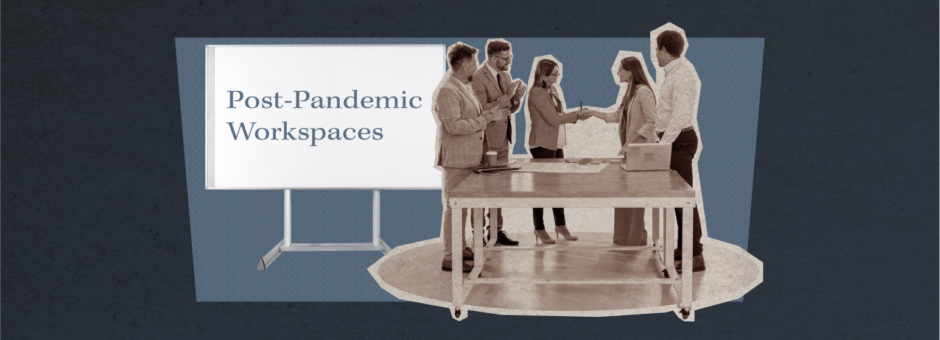Related:
An Examination of Remote Work, Creativity & Wellbeing
The COVID-19 pandemic disrupted traditional office environments, prompting a re-evaluation of how we work. As organizations navigated remote setups and hybrid models, the shortcomings of conventional office structures became evident. This blog explores the evolution of office spaces in response to changing work models, emphasizing flexibility, collaboration, and employee well-being.
Death of the Cubicle: The Evolution of Office Spaces Post-Pandemic
Pre-pandemic office layouts centered around cubicles and fixed workstations, hindering adaptability. The shift towards more flexible, employee-centric designs became imperative, with open floor plans and adaptable spaces gaining prominence.
Hybrid work models, combining remote and in-office work, have surged in popularity, prompting significant changes to office layouts.
Flexibility is key, with modular furniture and versatile layouts accommodating varying work arrangements. Traditional fixed workstations are being replaced by modular furniture and multipurpose areas catering to the needs of both remote and in-person workers. Collaborative zones equipped with technology facilitate seamless interaction between onsite and remote teams.
Hotdesking: A New Approach to Office Space
Hotdesking is a flexible office arrangement where employees do not have assigned desks but instead choose from available workstations on a first-come, first-served basis. This concept promotes workspace optimization, as desks are utilized more efficiently, reducing the need for excess office space.
Hotdesking encourages collaboration and cross-departmental interactions, as employees may find themselves seated near different colleagues each day, fostering networking and idea exchange. Additionally, hotdesking can save costs associated with maintaining dedicated workspaces for every employee.
However, hotdesking also poses challenges. Some employees may feel a lack of ownership over their workspace, leading to decreased morale or productivity. Ensuring desk availability and managing reservations can be logistical hurdles, requiring efficient systems and clear communication. Maintaining a clean and organized workspace becomes crucial to ensure a positive experience for all users.
Shared Spaces and Collaboration
Shared office spaces foster collaboration by providing environments specifically designed to encourage interaction and teamwork.
Brainstorming zones offer dedicated areas where employees can ideate and innovate together, and are often equipped with whiteboards, writable walls, and comfortable seating to facilitate creativity.
Communal lounges serve as informal meeting spaces where employees can gather for impromptu discussions, fostering a sense of community and camaraderie.
Project rooms are equipped with collaborative tools such as interactive displays, video conferencing systems, and collaborative software, enabling teams to work together seamlessly regardless of their physical location.
Companies like Google, known for their innovative office designs, incorporate these features effectively in their workspace layouts, creating vibrant environments that promote collaboration and innovation. Similarly, Airbnb’s offices feature communal areas designed to encourage interaction and idea sharing among employees, enhancing teamwork and productivity.
Closer to home, we find Deloitte’s Summit building here in Vancouver.1 A lot of attention has been paid to the striking visual of the building’s cubist structure, but its interior make-up is no less notable. There are reportedly no less than 18 different types of workspaces throughout the building’s 350,000 square feet. These workspaces, along with moveable furniture and walls, are designed to promote collaboration and happenstance idea sharing. One thing you won’t find? Private offices.
Health, Safety, and Well-Being in Office Design

Office designs have undergone significant changes post-pandemic to prioritize health, safety, and well-being. When companies asked their employees to return to the office after working remotely, they found that needs and expectations had evolved. Presenting a safe and pleasing workplace was nothing less than a pillar of their retention strategy.
Wellness areas, featuring amenities like meditation rooms, fitness centers, and relaxation spaces, promote mental and physical well-being among employees.
Biophilic elements, such as natural light, indoor plants, and green walls, are incorporated to improve air quality, reduce stress, and increase productivity.
Additionally, ergonomic furniture, including adjustable desks and chairs, minimizes discomfort and prevents musculoskeletal issues, enhancing employee comfort and efficiency.
Research indicates that incorporating these features into office designs can lead to lower stress levels, improved mood, and increased job satisfaction among employees, ultimately contributing to better overall performance and organizational success.
Microsoft’s headquarters in Redmond, Washington, is an example of such a facility.2 Biophilic design integrates natural elements like greenery, natural light, and views of nature into the built environment, which has been shown to reduce stress, enhance mood, and boost productivity among workers. Ergonomic workstations further demonstrate the company’s commitment.
Microsoft’s emphasis on these features underscores the growing recognition within the tech industry of the importance of creating workspaces that prioritize employee health and well-being.
Sustainable Offices a Priority
Sustainability is a priority throughout society and office construction is no different. One notable example of a Canadian company with an innovative office design is Canadian Nuclear Laboratories (CNL).3 Their newly-constructed office complex, the Science Collaboration Centre, is a testament to modern and sustainable design principles.
The six-story, 9,500 square meter facility located in Ontario at the Chalk River Laboratories campus serves as a central planning and collaboration space for the company’s science and technology program. Emphasizing environmental sustainability, the building is constructed using mass timber products sourced within Canada. This approach not only provides a modern office space but also significantly reduces the carbon footprint of the campus. The facility includes 44 meeting rooms, collaborative flex spaces, a university-style auditorium with 200 theatre-style seats, a library space, and a rooftop terrace, all designed to foster innovation and research in nuclear science
The Future of Office Design
The future of office design is poised to prioritize sustainability, adaptability, and employee-centricity. This shift entails embracing eco-friendly materials and energy-efficient systems to minimize environmental impact while creating healthier work environments. Flexible layouts will accommodate evolving work patterns, facilitating collaboration and innovation. Embracing agile methodologies and soliciting ongoing feedback from employees will enable organizations to swiftly adapt office spaces to meet changing needs and preferences. By integrating sustainable practices, fostering adaptability, and prioritizing employee well-being, future office designs will not only enhance productivity and creativity but also contribute to a more sustainable and fulfilling work experience for employees.
Cited Sources
1 Thomas, Knowlton. “The Latest and Greatest Tech Offices in Canada.” Tech Talent Canada, May 18, 2023. https://techtalent.ca/greatest-tech-offices-canada/.
2 “Americans Have a Nature Problem. Is ‘Biophilic Design’ the Solution?” NBCNews.com, March 8, 2018. https://www.nbcnews.com/mach/science/new-biophilic-buildings-use-quirky-features-bring-nature-indoors-ncna853996.
3 Ryanjl. “Canada’s National Nuclear Laboratory Opens Doors to Innovative and Sustainable New Office Complex – the Science Collaboration Centre.” Canadian Nuclear Laboratories, September 7, 2023. https://www.cnl.ca/canadas-national-nuclear-laboratory-opens-doors-to-innovative-and-sustainable-new-office-complex-the-science-collaboration-centre/.




